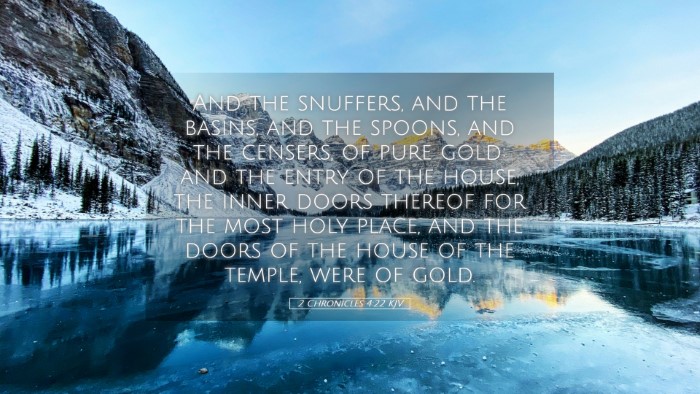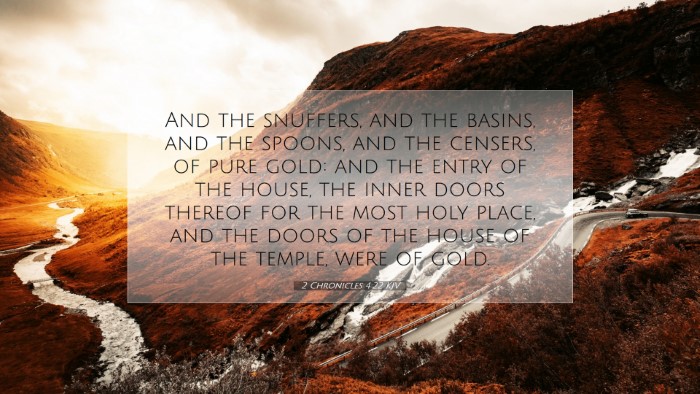Commentary on 2 Chronicles 4:22
Verse: 2 Chronicles 4:22 - "And the candlesticks of pure gold, five on the right side, and five on the left, before the oracle: with the flowers, and the lamps, and the tongs, of gold."
Introduction
The passage under study, 2 Chronicles 4:22, encapsulates significant elements pertaining to the temple's furnishings, specifically focusing on the golden candlesticks. This verse reflects the splendor of the sacred space designed for worship and the meticulous details involved in creating an environment conducive to divine encounters. In this commentary, we will draw insights from public domain sources, encompassing reflections from renowned theologians to deepen our understanding of this scripture.
General Overview
In this section, we will synthesize multiple commentaries to explore the key elements present in 2 Chronicles 4:22.
-
Importance of the Candlesticks:
The candlesticks in the temple are a symbol of divine illumination. Matthew Henry articulates that they represent the light of God's presence, essential in the worship life of Israel. This illumination indicates the prosperity of the temple, serving both a practical function of light and a spiritual metaphor for God's guidance.
-
Details and Symbolism:
Albert Barnes emphasizes the details noted in the design and arrangement of the candlesticks. Five on the right and five on the left suggest a duality that may underline divine completeness. The elaboration on the elements such as flowers and lamps signifies not just beauty but the flourishing of faith and God's kindling spirit within his people.
-
Significance of Gold:
Adam Clarke highlights the use of pure gold in the construction of these items. Gold symbolizes purity, divinity, and value, thus indicating that the worship services within the temple demand the utmost respect and sanctity. The reference to this precious metal highlights the worthiness of God and the seriousness with which worship should be approached.
Theological Insights
This verse, while speaking of a physical structure, bears profound theological implications that can enlighten pastors, students, and theologians.
-
The Role of Light in Worship:
The candlesticks serve as a reminder of Jesus Christ, who is often referred to as the Light of the World. As Henry points out, the light brings clarity and understanding into our lives, drawing parallels between the liturgical practices of Israel and the Christian call to let our light shine before men (Matthew 5:16).
-
The Cultural Context:
Barnes elucidates the cultural significance of the temple furnishings. In a time when worship occurred in various forms and places, the distinctiveness of the temple highlighted God's unique relationship with Israel. This passage reinforces the idea of holiness and dedication required in approaching God.
-
The Impact of Aesthetic Worship:
Clarke opines on the beauty of the temple's design, emphasizing that aesthetics in worship should not be overlooked. The elaborate and beautiful design signifies that worship should attract the attention of believers, captivating them to engage more deeply with God.
Practical Application
The principles from this verse can transcend time and culture, offering practical applications for today's believers.
-
Prioritizing Worship:
Just as the Israelites prioritized the construction and adornment of the temple, today's church leaders must likewise emphasize creating an environment where worship can thrive. This means investing resources into our worship spaces, ensuring they reflect the holiness of God.
-
Illuminating Lives with Christ's Light:
The call to reflect Christ, the true light, becomes imperative. Pastors are challenged to equip their congregations to be bearers of light within their communities, echoing the significance of the candlesticks positioned before the oracle.
-
Creating Beauty in Worship:
This passage encourages a thoughtful approach to worship settings and the need for aesthetic beauty in worship. It implores churches to consider how their space can reflect the glory of God, facilitating a deeper worship experience.
Conclusion
2 Chronicles 4:22, in its description of the candlesticks and temple furnishings, provides a rich tapestry from which to draw spiritual, theological, and practical lessons. Engaging with the insights from Matthew Henry, Albert Barnes, and Adam Clarke, we recognize the importance of worship, the symbolism of light, and the necessity of honor in our approach to God. As we heed these lessons, may our worship spaces reflect the glory of our God, illuminating the world with His truth.


